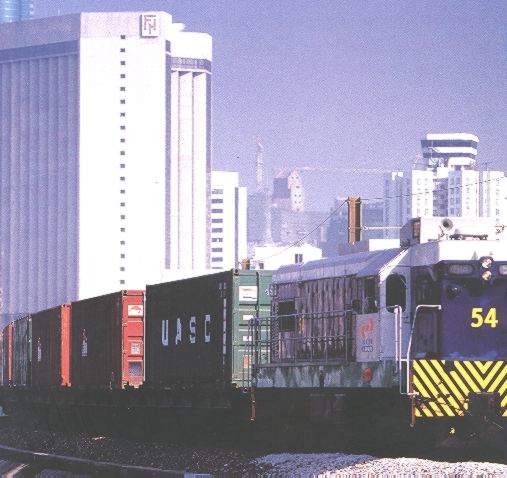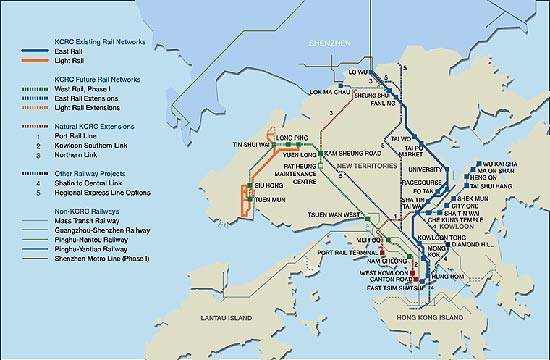Hong Kong’s heavy rail network is primarily arranged on two axes. Patronage of the East Rail route has soared almost six-fold since electrification in 1983. A fleet of 451 GEC-Alstom-built EMU vehicles share the same tracks as trains continuing to Shanghai and Beijing, as well as commercially vital freight, mainly container traffic.
East Rail’s network runs from Hung Hom at the province’s southern tip, to Lo Wu, close to the border with Shenzhen province. Both passenger and freight services have experienced rapid growth in parallel with the island’s own economic success.
Every day East Rail carries about 800,000 passengers during a 19.5hr period. Every hour during the morning peak period, 48 domestic passenger trains travel into and out of Hung Hom station.
As East Rail also carries a substantial amount of long-distance traffic between Hong Kong, Lo Wu, Shanghai and Beijing, it is regarded as an important trunk route on the Chinese railway system.
The project
Expansion of Hong Kong’s rail network is driven by a massive increase in population and business activity, not halted by the handing over of the province from British to Chinese control.
Eager to demonstrate its commitment to exploiting its growing economic prosperity, the Chinese government invited the Kowloon Canton Rail Corporation (KCRC) to forward a combined bid during 1998 to construct and operate both the Ma On Shen extension of the West Rail system, and three East Rail extensions. The most important among these is from Hung Hom to Tsim Sha Tsui, which was completed in October 2004.
Urgent action is needed to ease pressure on the busy Lo Wu interchange, with a new spur line from Sheung Shui to Lok Ma Chau well underway.
These new rail links and extensions will make travelling between the North East New Territories and the urban areas much easier, and will provide another direct link with the Chinese mainland.
Infrastructure
Major infrastructure development demands an extremely sensitive approach, well illustrated by KCRC’s investment of HK$1 billion in a noise mitigation project on existing routes, involving enclosure of many elevated track sections with sound-deadening material.
Improvements at many stations have also been carried out. Lo Wu has a special tidal flow system for immigration and customs. To meet growing demand for domestic and cross-boundary rail passenger services, KCRC is moving ahead with detailed design for the construction of three East Rail extension lines – Ma On Shan Rail, Tsim Sha Tsui Extension and Lok Ma Chau Spur Line. Costing around HK$26 billion, the Tsim Sha Tsui extension was completed in 2004, and the Lok Ma Chau Spur line is well under way.
Ma On Shan (MOS) Rail provides reliable and convenient rail services between Ma On Shan and Tai Wai. It runs over a length of 11.4km and comprises nine stations, including Tai Wai, Che Kung Temple, Sha Tin Wai, City One, Shek Mun, Tai Shui Hang, Heng On, Ma On Shan and Wu Kai Sha. The stations are within easy walking distance of the area’s major residential developments.
The railway is built primarily on a viaduct with a small section in the middle running at grade along the central divider of Tate’s Cairn Highway, so as to minimise land take and disruption to road traffic.
Finally, the Lok Ma Chau Spur extension is urgently needed to cope with increasing cross-boundary passenger traffic between Hong Kong and Mainland China. On average, 250,000 crossings are made daily via Lo Wu, reaching 300,000 during festival holidays peak travel. The line, a mixture of tunnels and viaducts should open in 2007.
A 7.4km spur line will run from Sheung Shui to a new station at Lok Ma Chau, with a two-level pedestrian bridge across Shenzhen River with Huanggang. Passengers will have direct transfer to Shenzhen (formerly Canton) Metro System, for completion by 2004.
The alignment will be a 4.3km-long tunnel between Sheung Shui and Chau Tau, rising above ground level as viaducts from Chau Tau to Lok Ma Chau.
Rolling stock
Major refurbishment of the 1980s Alstom rolling stock was undertaken from 1996 at a cost of HK$1.25 billion, resulting in a 15% increase in capacity. Hopper ventilation windows and new passenger information displays were also provided.
The trains have been given an improved traction package, incorporating up-to-date electronic control systems. Longer-distance journeys are serviced by two double-deck rakes of rolling stock, designated KTT, capable of push-pull operation, and introduced from August 1998.
Five Kinki Sharyo standard class coaches and one first-class vehicle are powered by Lok 2000 locomotives, built by Adtranz and SLM of Switzerland. For peak traffic, two sets can be coupled together as a single 12-coach train. New trains are on order for the three extensions.
Signalling and communications
A signalling upgrade is an integral part of the drive to increase capacity. An automatic train protection system allows train paths to be increased from 20 to 24 per hour each way.
Services are co-ordinated from a new control centre in the Kowloon Canton Railway Corporation’s operations headquarters building at Fo Tan. East Rail stations’ communications facilities improvements include installation of new payphones on all platforms, and a passenger information system.
The future
East Rail has changed from a railway serving primarily longer distance travellers going into the Mainland into a major mass transit commuter railway. East Rail’s domestic service carried some 205 million passengers in 2001 or 562,500 passenger trips a day.
Carrying capacity has risen by 38%, with 20 to 24 trains per hour per direction in the peak. At constant prices, the cost of carrying one passenger per kilometre on East Rail fell 13% from 46.8 cents to 40.7 cents between 1991 and 2001.













